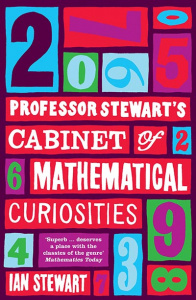Professor Stewart’s Cabinet of Mathematical Curiosities
 By Ian Stewart
By Ian Stewart
Review by Matthew (Mathematics)
Most people’s first experience of a “maths book” is a thick tattered school textbook filled with tedious exercises. With such a book it is easy to get bored and overlook the beauty of mathematics. However, one just needs to dig a little deeper to realise that very little of maths involves monotonous calculations (after all we have computers for that!). I discovered this with the help of Professor Stewart’s Cabinet of Mathematical Curiosities.
This book isn’t what you would think of when I say book, it is more a collections of problems and curiosities from all areas of mathematics. The entries in this book are rarely more than two pages long so can be quickly looked at whenever you have a bit of spare time; however some of the problems in the book are deceptively simple (indeed some are yet to be solved!) and can leave you thinking about them for days.
One day I flipped to an entry called Pick’s Theorem and saw that if a polygon whose vertices lie on the points of a square lattice (as in the picture), where each point is spaced at interval of one unit, then the area A of the polygon can be calculated from the number of boundary points B (red) and interior points I (blue) by the formula A = 1/2B + I – 1. (In this example B = 15 and I = 31 so A = 15/2 + 31 – 1 = 37.5) I felt that this theorem was wonderfully beautiful and simple and I went onto the internet (i.e. Wikipedia!) and read through a proof of it.
As I said before sometimes at school I thought that maths got tedious and repetitive. I struggled however to find any good maths book because many maths books are just textbooks in disguise. This often made me doubt whether maths was really the right choice for me at university; after all what if maths at university was just going to be manipulating large numbers and solving complicated equations? This book made discover the diversity of areas of mathematics and realise that my impression of university mathematics was very from the reality.
There is a rather tantalising entry in the book entitled How to Win a Million Dollars by Proving the Obvious, which discuss the P = NP computer science open problem that turns out to be “not that obvious”. The book also contains an acronym from the science fiction author Robert A. Heinlein: TANSTAAFL – There Ain’t No Such Thing As A Free Lunch!
Be warned though this book also includes some (rather poor) mathematical jokes (I would skip over them!)
Review by Dominic (Mathematics MMath)
Professor Stewart’s Cabinet of Mathematical Curiosities is a book about… well, exactly what the title sounds like. Professor Ian Stewart, a Fellow at Warwick University and bearer of the Royal Society’s Michael Faraday Medal has a knack for retelling difficult concepts in maths in a very succinct and comprehensible manner, exactly in the way a teenager can understand. In this book, Professor Stewart recounts various mathematical topics from his Cabinets, his maths notebooks that he has kept from the age of 14. In my opinion, the chapters in Professor Stewart’s book, ranging from short puzzles to mini essays capture the fun and interesting side of maths so that everyone can enjoy it.
My particular favourites are the sections on Hilbert’s Hotel, dealing with infinity and countability of sets, and the Riemann Hypothesis, which is a famous unsolved problem in mathematics. His chatty style makes these sections very easy to read and understand, even though he explains concepts not usually covered until university! Looking back at the book now, I realise how wide the range of topics is: number theory, geometry, topology, probability and statistics, chaos theory, maths-themed jokes, and much, much more. Speaking of jokes, do you know why the chicken crossed the Möbius Strip? (Find out in the book!)
Would I recommend you read it? Absolutely! This book has almost single-handedly provided me with a massive background knowledge of mathematics — not just famous problems and concepts but also logical puzzles and brainteasers. I have noticed already that so many of these topics have turned up in my first term at university, and I would not at all be surprised if they continue to do so throughout my maths degree. I would also highly recommend keeping maths notebooks of your own. That way, you can find areas of maths you really love and keep notes on them and research them, highly valuable skills for your time at university. And who knows, perhaps you’ll be able to publish them in a book one day!
Professor Stewart’s Cabinet of Mathematical Curiosities by Ian Stewart
ISBN-10: 1846683459
ISBN-13: 9781846683459
Try checking the availability of this book at your school or local library or explore second hand bookshops and websites. You may also wish to purchase from either Amazon or Blackwell’s.
